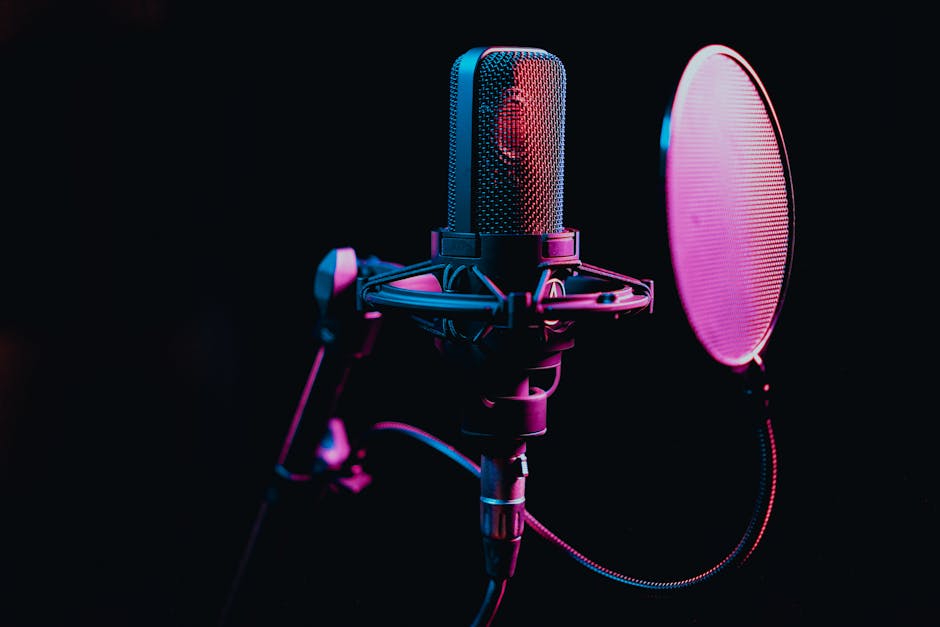The Impact of a Good Pop Filter on My Podcast’s Sound Quality.
As a podcaster, I’ve learned that the journey to pristine audio is paved with many small, yet significant, upgrades. For a long time, I focused on the big-ticket items: a great microphone, a quiet recording space, and powerful editing software. Yet, there was always a subtle harshness, an unprofessional edge to my sound that I couldn’t quite pinpoint. It wasn’t until I truly understood and invested in a good pop filter that I witnessed a transformative change in my podcast’s sound quality. This wasn’t just an accessory; it was the missing piece that elevated my audio from good to genuinely excellent, directly impacting my listeners’ experience and my own production workflow.
My Journey from “Pops” and “Thumps” to Pristine Vocals
When I first started podcasting, I was blissfully unaware of what a “plosive” was. All I knew was that sometimes, when I spoke certain words – particularly those starting with ‘P’ or ‘B’ – there’d be an audible thud or blast of air that sounded incredibly jarring. My microphone, a decent condenser mic, was picking up every single one with alarming clarity. These weren’t just minor imperfections; they were distracting explosions of sound that pulled listeners out of the narrative. My early episodes were plagued by these sonic interruptions, leading to a constant battle in post-production, trying to manually reduce or remove them, often with mixed results and a lot of wasted time. It felt like I was always fighting against my own voice, rather than letting it shine.
The recommendation for a pop filter often came up, but I initially dismissed it as an optional extra, perhaps something for professional studios. I even tried a cheap foam cover on my microphone, thinking it would do the trick. While it offered *some* minimal protection, it also muffled my voice slightly and didn’t truly eliminate the most aggressive plosives. It was a compromise, not a solution. The real revelation came when I invested in a higher-quality, dual-mesh pop filter. The difference was immediate and profound, transforming my understanding of what a “good” pop filter could actually achieve for my podcast’s sound quality.
Unmasking the Culprits: How a Pop Filter Tames Plosives and Breath Noises
The primary, and most obvious, impact of a good pop filter on my podcast’s sound quality was its unparalleled ability to eliminate plosives. These are those harsh bursts of air that rush from your mouth when you enunciate ‘P’s, ‘B’s, ‘T’s, and ‘K’s. Without a barrier, this sudden gust of air hits the microphone’s diaphragm directly, causing an overload that registers as a loud, low-frequency ‘pop’ or ‘thump’. It’s akin to a sudden gust of wind hitting a sail, causing it to flap violently. My high-sensitivity condenser microphone, designed to capture every nuance, was ironically also capturing these undesirable blasts with brutal efficiency.
A good pop filter acts as a sonic shield, dispersing that direct blast of air before it ever reaches the microphone. Instead of the concentrated force hitting the diaphragm, the air is diffused and spread out, effectively neutralizing the plosive without affecting the clarity of the vocal sound itself. This isn’t just about reducing volume; it’s about preventing the physical impact on the microphone capsule. Beyond plosives, I also noticed a significant reduction in harsh breath noises. While some breath is natural and adds to realism, overly loud or sharp inhalations and exhalations can be distracting. The pop filter, by creating a slight distance and diffusing air movement, subtly smooths out these sounds, making them less intrusive and more natural within the overall audio landscape of my podcast.
Beyond the Blast: Elevating Overall Speech Clarity and Listener Comfort
While eliminating plosives was the most immediate and dramatic improvement, the deeper impact of a good pop filter on my podcast’s sound quality extended to the overall clarity and comfort of the listening experience. When listeners aren’t constantly bracing for the next ‘pop,’ their brains are freed up to focus entirely on the content. This might seem subtle, but it’s incredibly powerful. Distracting noises create cognitive load, making the listener work harder. By removing these harsh elements, my podcast became easier to listen to for extended periods.

Furthermore, without the constant threat of plosives, I found myself speaking more naturally and confidently. Before, I was subconsciously trying to pull back from the mic or adjust my speaking style to avoid pops, which often led to an unnatural delivery. With the pop filter in place, I could maintain optimal microphone proximity, leveraging the proximity effect for a warmer, richer vocal tone without fear of overwhelming the microphone. This allowed for a more consistent and engaging vocal performance, which directly translated into a more enjoyable experience for my audience. The entire soundscape of my podcast became smoother, more polished, and significantly more professional, enhancing the perceived value of my content.
The Subtle Art of Sibilance Management
Interestingly, a good pop filter also played a role in managing sibilance – those sharp, hissing ‘S’ sounds that can be piercing to the ear. While a pop filter isn’t primarily designed for sibilance control (a de-esser plugin is usually the go-to for that), its presence creates a slight buffer between the mouth and the mic. This physical separation can subtly reduce the direct impact of high-frequency sibilant sounds, making them slightly less aggressive before they even hit the microphone. It’s not a complete fix, but it contributes to a more balanced and less fatiguing listening experience, especially when combined with essential podcast editing techniques.
The Unseen Hero: Reducing Post-Production Headaches and Saving Time
One of the most profound, yet often overlooked, impacts of a good pop filter on my podcast’s sound quality was the dramatic reduction in my post-production workload. Before, editing my vocal tracks was a tedious dance of identifying and manually treating every single plosive. This involved zooming into waveforms, carefully selecting the offending spike, and then either attenuating it, using a high-pass filter, or even attempting to redraw the waveform – a process that was time-consuming, mentally exhausting, and often led to imperfect results. Sometimes, over-editing a plosive could introduce other artifacts or make the audio sound unnatural.
With a reliable pop filter, that entire segment of my editing process virtually disappeared. I could spend my valuable post-production time on more creative tasks, like crafting compelling intros and outros, mixing music, sound design, or refining the overall flow of the episode. This efficiency gain wasn’t just about saving minutes; it was about saving hours across multiple episodes, allowing me to produce more content or simply reclaim personal time. It also meant less stress and frustration during editing, making the entire podcasting process more enjoyable and sustainable. The clean raw audio I now capture is a testament to the power of addressing sound issues at the source rather than trying to fix them in post-production.
From Amateur to Audiophile: The Professional Polish a Pop Filter Delivers
Ultimately, the most significant impact of a good pop filter on my podcast’s sound quality was the elevation of my entire show’s perceived professionalism. In today’s crowded podcasting landscape, listeners have high expectations for audio quality. A podcast riddled with pops, thumps, and harsh breath sounds immediately signals amateurism, regardless of how compelling the content might be. It creates a barrier to entry, making it harder for new listeners to engage and for existing ones to stay subscribed. My goal was always to produce a podcast that sounded as good as, if not better than, established shows, and the pop filter was a crucial step in achieving that.
Clean, clear audio conveys respect for the listener and competence from the producer. It suggests attention to detail and a commitment to quality. When my audio became consistently free of plosives and breath blasts, the feedback from my audience shifted. Instead of comments about sound issues, I started receiving praise for the clarity and professional feel of my episodes. This intangible benefit – the trust and credibility built through superior audio – is invaluable. It helps my podcast stand out, retains listeners, and fosters a more engaged community, allowing my message to be heard without sonic interference.
Choosing My Sonic Shield: What Makes a Pop Filter Truly “Good” for Podcasting
My journey taught me that not all pop filters are created equal. The term “good” isn’t just about price; it’s about effective design and material. Here’s what I learned made a significant difference in the impact on my podcast’s sound quality:
- Material Matters: I found that dual-layer nylon mesh pop filters or high-quality metal mesh filters were far superior to the basic foam screens. Foam can sometimes muffle high frequencies, while a well-designed mesh allows sound to pass through uncolored while effectively diffusing air. Metal mesh, in particular, tends to be more durable and easier to clean.
- Size and Shape: A larger diameter pop filter provides a wider sweet spot, giving you more flexibility in microphone positioning and accommodating slight movements during recording. Curved designs can also be more effective at dispersing air.
- Gooseneck Quality: This is often overlooked but crucial. A sturdy, flexible gooseneck that holds its position is essential. There’s nothing worse than a flimsy gooseneck that constantly sags or drifts, forcing you to readjust mid-sentence. My good pop




Post Comment